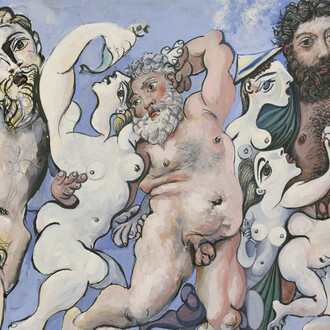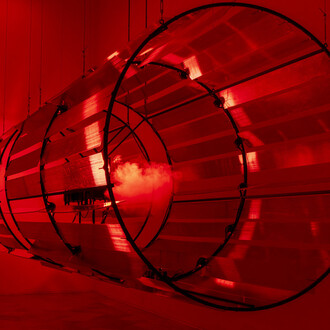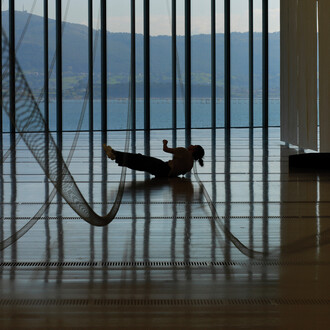“The Fall of Man,” or “Adam and Eve,” as interpreted by Rubens, differs in several respects from Titian’s original. Rubens permits himself to remove and add motifs and figures – most notably the red parrot, which is a character in its own right; unlike the fox curled at Eve’s feet, the parrot reacts to the scene unfolding before it. The most striking difference, however, lies in what happens to Eve in each version. In Titian’s painting, she seems somewhat absent, almost mechanical, as though entering a dreamlike state, while Adam is only beginning to perceive what is happening. In Rubens’s version, Eve is already entranced: her half-open mouth – almost a smile – her shining eyes, Adam’s fearful expression, and the way his body seems ready to forcefully shake her awake all confirm that she has already succumbed to rapture. During his second trip to Spain, Rubens copied several of Titian’s works, and of those recorded, “Adam and Eve” is perhaps the only one that, in some sense, surpasses the original. I share the view that beyond the elements added or removed, Rubens’s intent was to heighten emotional intensity – introducing shifts that support a more distinct and expressive narrative.
This dialogue between copy and original is not only relevant to the work Marina presents here for the first time, but also opens space to reflect on broader questions around contemporary painting. One might argue that Rubens’s painting is more powerful than Titian’s, and still, it is a copy. So then, can painting offer something new when so much has already been done? This leads to another question: that of tradition and inheritance.
By repeatedly copying Titian, Rubens engaged in a kind of apprenticeship via the common exercise of earning from the master by way of his work. Yet in the version that concerns us here, Rubens does more than emulate. He transforms tradition into an inheritance, something that transcends the technical and moves beyond reality, while remaining tangible and physical. How else might one explain the difference between two paintings nearly a century apart? Art presents us with a different kind of reality: “The artist is probably the only true visionary, because what they see is real. They help us to see what we have always known. They return us to reality so that we may endure it, rejoice in it, and even begin to change it”1.
As spectators, we do not receive that reality through technical transmission, that is through tradition, but as inheritance: a filial, rather than merely familial, bond. Joseph Roach described “surrogation” as a form of cultural continuity founded on repetition and the creation of “myths of legitimation and origin”. These myths depend on forgetting, on the reinvention of historical meaning, where memory reveals itself as imagination. From this perspective, we can read Marina’s version of “Adam and Eve,” titled in this exhibition “My hands drag me”. And not only read it but also recognise in it a filial bond with her predecessors.
Not long ago, someone asked me what I see in painting. I struggled to answer. I wanted to persuade with words, yet often they slip beyond language. Marina’s painting, in this case, and more broadly, I do not understand as an evocation of memory or tradition, but as a generator of new memories. The reality my eyes perceive is not the one presented by the painting: the artist, as true visionary, generates reality. It is often said that painters teach writers how to see.
Painting can be read in different contexts – political, historical, intimate. In Marina’s work, two elements stand out: the body and light as a generator of reality. What exists is us and our surroundings, separate and seemingly stable entities. But is that the only reality available to us? Modern artists explored the body as a conduit for affect circulating between the human and the nonhuman, the physical and the ethereal. It is within this lineage that Marina’s work takes its place: as an artist who must remain close to her fantasies in order to stay alert to the truths they contain.
The bodies Marina paints have a liquid condition – not porous boundaries, but continuous flows. Between the vegetal and the human, the probable and the possible, these bodies shift form again and again, without ever closing. Entering this exhibition – one that does not allow us to forget it has been created by someone – we too become liquid: background and foreground, container and contained, texture and witness. This alternative reality may originate from that sensation in the studio, when one encounters a painting and knows it has just been made and could be made again. On the walls of a gallery or museum, that possibility no longer exists. Here, however, the intimacy of looking returns us to that experience.
Painting is often thought to be above all about colour. In fact, it is about light. “Black is described as the absence of light; if that were so, we could not see colour. Light is trapped in it and struggles to reach the surface, like grass breaking through cement”2. “All painting is an exercise in light. The subject may be interesting, but it is its interaction with light that sets it apart from mere representation”3. In Marina’s work, this is evident. Textures, tools, even pigments and grains of salt become ways of playing with light. What matters is not light’s presence or absence, but how colour exists in constant transformation, “and what must be avoided at all costs is letting things become too clear”4.
Can a reality exist and yet remain partially veiled? For me too, painting is rapture.
Memory is a traitor and …
life does not contain the past tense;
the sunset one saw yesterday […]
has not really been seen
unless one is prepared
to see it every day.(James Baldwin)
Notes
1 Yoran Cazac.
2 James Baldwin on Beauford Delaney.
3 Lloyd Branson.
4 James Baldwin.










![Saul Steinberg, The museum [El museo] (detalle), 1972. Cortesía del Museo de Arte Abstracto Español](http://media.meer.com/attachments/dfbad16c22c5940b5ce7463468ac8879f3b4bf23/store/fill/330/330/042ecf3bcd2c9b4db7ddbc57cb32e950c095835f7b5cd55b6e1576a6e78c/Saul-Steinberg-The-museum-El-museo-detalle-1972-Cortesia-del-Museo-de-Arte-Abstracto-Espanol.jpg)


